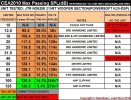@nn_in
The way I see it, there are 2 aspects to good bass.
1. What the speakers can do and what the room can reinforce (or mess up)
2. What is in the recording
It is fairly easy to assess the capability of the speakers in a given room.
If a given speaker is rated at say 50Hz (3dB) it means it will meaningfully reproduce anything a little above this frequency.
How good or bad is this depends on the speaker design, material, position, placement, equipment, etc.
Let's assume that the speakers are "good" and placement is "satisfactory" and chain is "decent".
Positive room gain is usually when the musical notes at boundary condition is given a bit of help to pressurize them room.
It can sometimes be too much of a good thing

(including room modes)
Now, in studio recorded music, there is very little content that goes below 50 Hz (let alone below 40 Hz).
This is for music and it's associated instruments.
Many a time recording engineers would have EQ'ed it to a practical playback level (maybe even EQ'ed it out).
The real kicker comes when listening to live music, say an opera or rock concert or big band jazz/blues recorded in a closed auditorium.
Here the mic would have picked up what that concert hall adds to the LF of certain instruments.
If the recording engineer decides to keep this in the recording, then a 10/12" sub will bring it out subtly.
Regular 5/6/8" woofers can't play this at meaningful SPL. As
@RRR said, laws of physics.
Cheers,
Raghu



